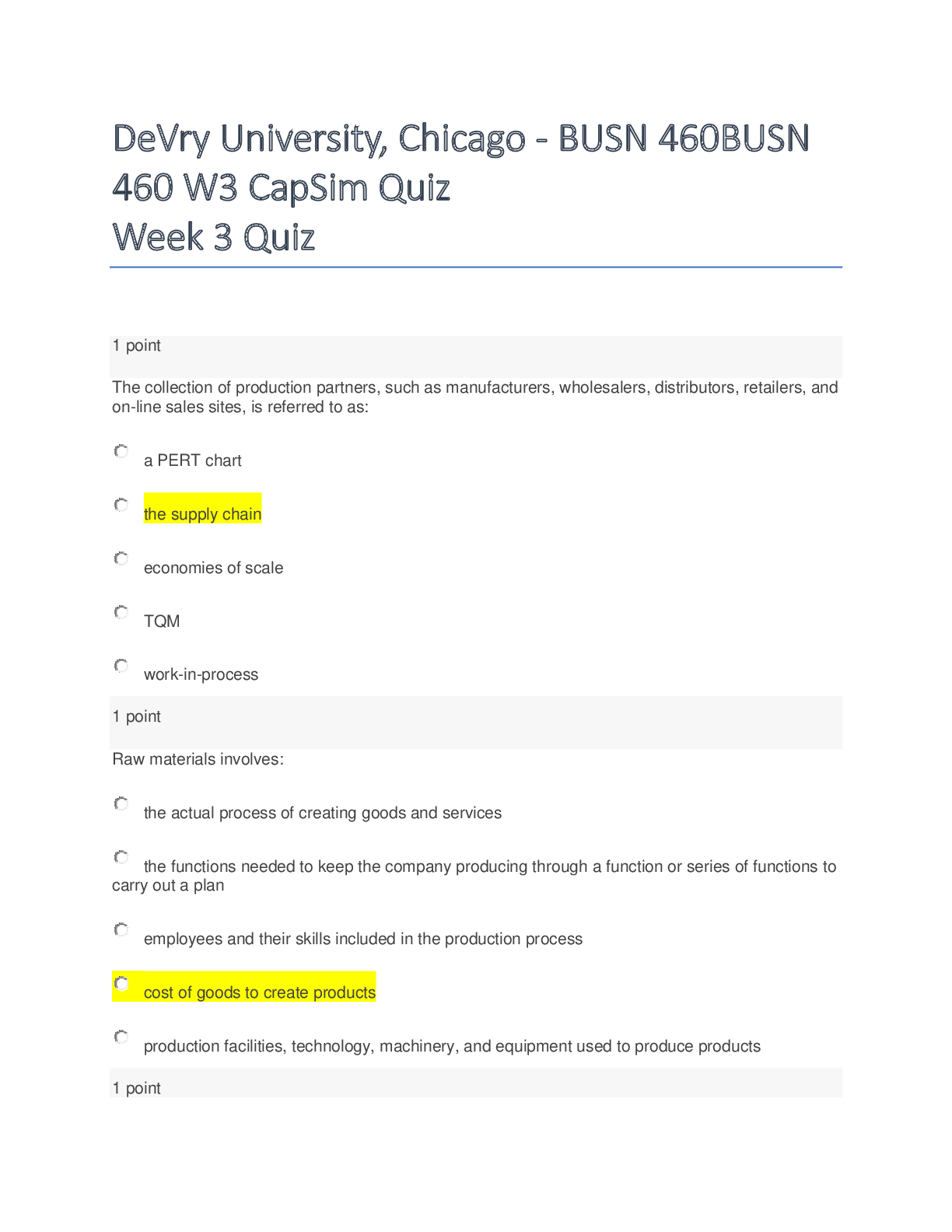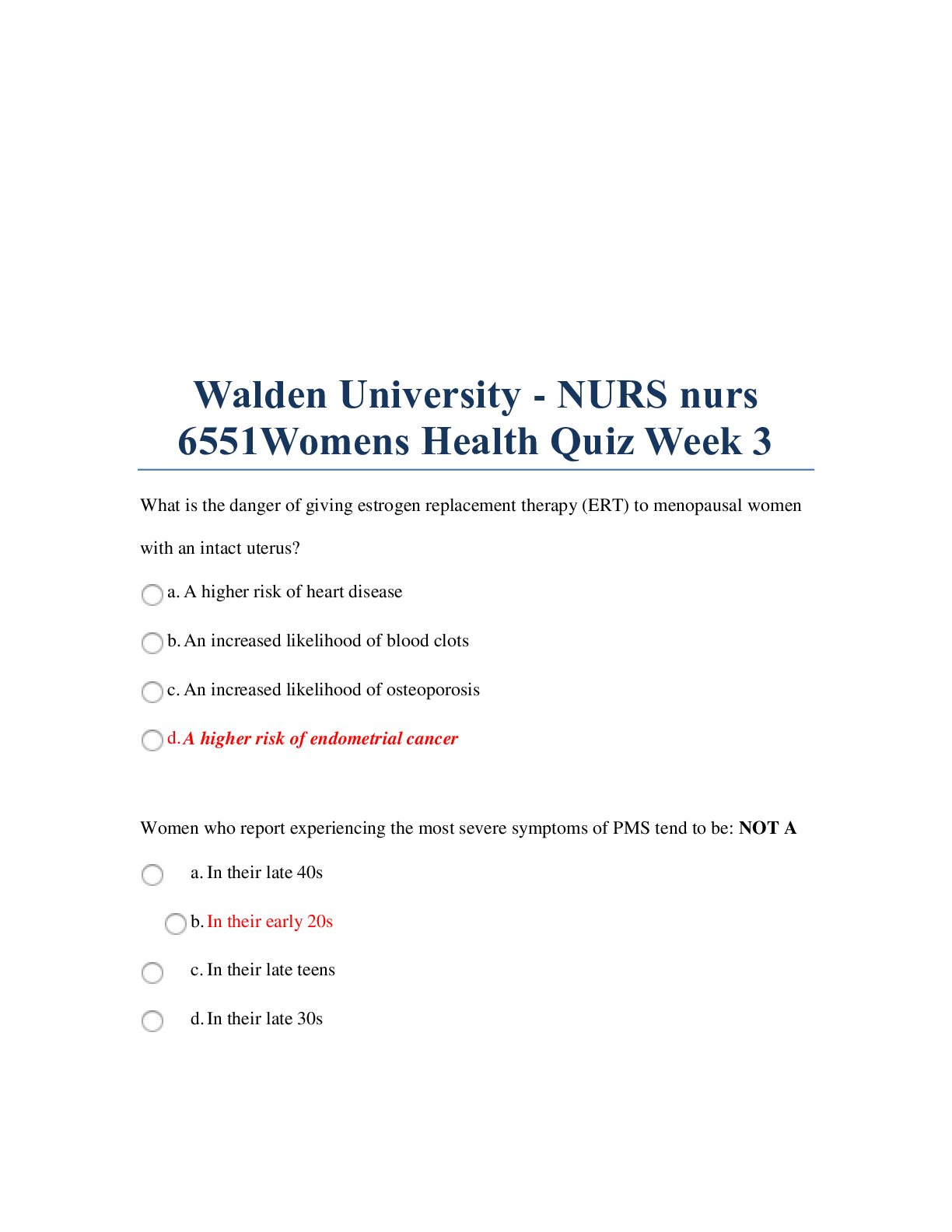Management > QUESTIONS & ANSWERS > MN 551 Quiz Week 3 Kaplan University (All)
MN 551 Quiz Week 3 Kaplan University
Document Content and Description Below
A patient is experiencing impaired circulation secondary to increased systemic arterial pressure. Which of the following statements is the most relevant phenomenon? Question options: ue to vascular... resistance ause of backpressure against the left ventricle ty due to aortic resistance t because of arterial stenosis A 54-year-old man with a long-standing diagnosis of essential hypertension is meeting with his nurse practitioner. The patient's nurse practitioner would anticipate that which of the following phenomena is most likely occurring? Question options: angiotensin I to angiotensin II in his lungs causes increases in blood pressure and sodium reabsorption. ing an effect on his chemoreceptors and baroreceptors, resulting in vasoconstriction. is adrenal gland is initiating the renin-angiotensin-aldosterone system. lomerular cells are releasing aldosterone as a result of sympathetic stimulation. A patient in the intensive care unit has a blood pressure of 87/39 and has warm, flushed skin accompanying his sudden decline in level of consciousness. The patient also has arterial and venous dilation and a decrease in systemic vascular resistance. What is this patient's most likely diagnosis? Question options: A 55-year-old male who is beginning to take a statin drug for his hypercholesterolemia is discussing cholesterol and its role in health and illness with his nurse practitioner. Which of the following aspects of hyperlipidemia would the nurse practitioner most likely take into account when teaching the patient? Question options: consequence of diet and lifestyle rather than genetics. often characterized as being beneficial to health. abolic waste product that the liver is responsible for clearing. treatment is to eliminate cholesterol from the vascular system. Which of the following assessment findings in a newly admitted 30-year-old male patient would be most likely to cause his nurse practitioner to suspect polyarteritis nodosa? Question options: ure is 101.9°F and he is diaphoretic (heavily sweating). short of breath and his oxygen saturation is 87%. ressure is 178/102 and he has abnormal liver function tests. rk indicates polycythemia (elevated red cells levels) and leukocytosis (elevated white cells). In which of the following patient situations would a nurse practitioner be most justified in preliminarily ruling out pericarditis as a contributing pathology to the patient's health problems? Question options: an whose admission blood work indicates elevated white cells, erythrocyte sedimentation rate, and C-reactive protein levels 1 This study source was downloaded by 100000831988016 from CourseHero.com on 04-27-2022 07:31:07 GMT -05:00 https://www.coursehero.com/file/24614031/MN-551-Quiz-Week-3docx/ e man who is complaining of chest pain that is exacerbated by deep inspiration and is radiating to his neck and scapular ridge diminished S3 and S4 sounds, an irregular heart rate, and a history of atrial fibrillation whose ECG was characterized by widespread T wave inversions on admission but whose T waves have recently normalized A nurse practitioner has ordered the measurement of a cardiac patient's electrolyte levels as part of the patient's morning blood work. Which of the following statements best captures the importance of potassium in the normal electrical function of the patient's heart? Question options: ement of one potassium ion for one sodium ion across the cell membrane results in the production of an action potential. of cardiac cell membranes to potassium allows for action potentials achieved by the flow of sodium ions. al to establishing and maintaining the resting membrane potential of cardiac muscle cells. the metabolism of ATP, producing the gradient that results in electrical stimulation. As part of the diagnostic workup for a male patient with a complex history of cardiovascular disease, the care team has identified the need for a record of the electrical activity of his heart, insight into the metabolism of his myocardium, and physical measurements, and imaging of his heart. Which of the following series of tests is most likely to provide the needed data for his diagnosis and care? Question options: ion, cardiac CT, exercise stress testing vels, chest auscultation, myocardial perfusion scintigraphy ardiac MRI, echocardiogram PET scan, ECG A patient has suffered damage to his pericardium following a motor vehicle accident. Which of the following consequences should the nurse practitioner be most likely to rule out? Question options: restraint of the left ventricule during the contraction/relaxation cycle n from infectious organisms on of myocardial contraction An older adult female patient has presented with a new onset of shortness of breath, and the patient's nurse practitioner has ordered measurement of her BNP levels along with other diagnostic tests. What is the most accurate rationale for the nurse practitioner's choice of blood work? Question options: vated in cases of cardiac asthma, Cheyne-Stokes respirations, and acute pulmonary edema, and measurement can gauge the severity of pulmonary effects. te with the patient's risk of developing cognitive deficits secondary to heart failure and consequent brain hypoxia. indicator of the effectiveness of the RAA system in compensating for heart failure. s a compensatory mechanism during heart failure and measuring it can help differentiate the patient's dyspnea from a respiratory pathology. A 31-year-old woman with a congenital heart defect reports episodes of lightheadedness and syncope, with occasional palpitations. A resting electrocardiogram reveals sinus bradycardia and she is suspected of having sick sinus syndrome. Which of the following diagnostic methods is the best choice to investigate the suspicion? Question options: 2 This study source was downloaded by 100000831988016 from CourseHero.com on 04-27-2022 07:31:07 GMT -05:00 https://www.coursehero.com/file/24614031/MN-551-Quiz-Week-3docx/ g study ing CG The nurse practitioner for a cardiology practice is responsible for providing presurgical teaching for patients who are about to undergo a coronary artery bypass graft. Which of the following teaching points best conveys an aspect of the human circulatory system? Question options: sure varies widely between arteries and veins, and between pulmonary and systemic circulation.” quarter of your blood is in your heart at any given time.” nd blood volume roughly mimic one another at any given location in the circulatory system.” ght-sided pumping action at each beat of the heart must equal each other to ensure adequate blood distribution.” A 72-year-old woman with a recent onset of syncopal episodes has been referred to a cardiology group by her family physician. As part of the patient's diagnostic workup, the nurse practitioner conducting the intake assessment has ordered a Holter monitor for 24 hours. Which of the fol [Show More]
Last updated: 1 year ago
Preview 1 out of 5 pages
Instant download
.png)
Buy this document to get the full access instantly
Instant Download Access after purchase
Add to cartInstant download
Reviews( 0 )
Document information
Connected school, study & course
About the document
Uploaded On
Apr 27, 2022
Number of pages
5
Written in
Additional information
This document has been written for:
Uploaded
Apr 27, 2022
Downloads
0
Views
60

.png)
.png)
.png)
.png)
.png)
.png)
.png)
.png)
.png)
.png)
.png)




.png)




.png)

.png)


